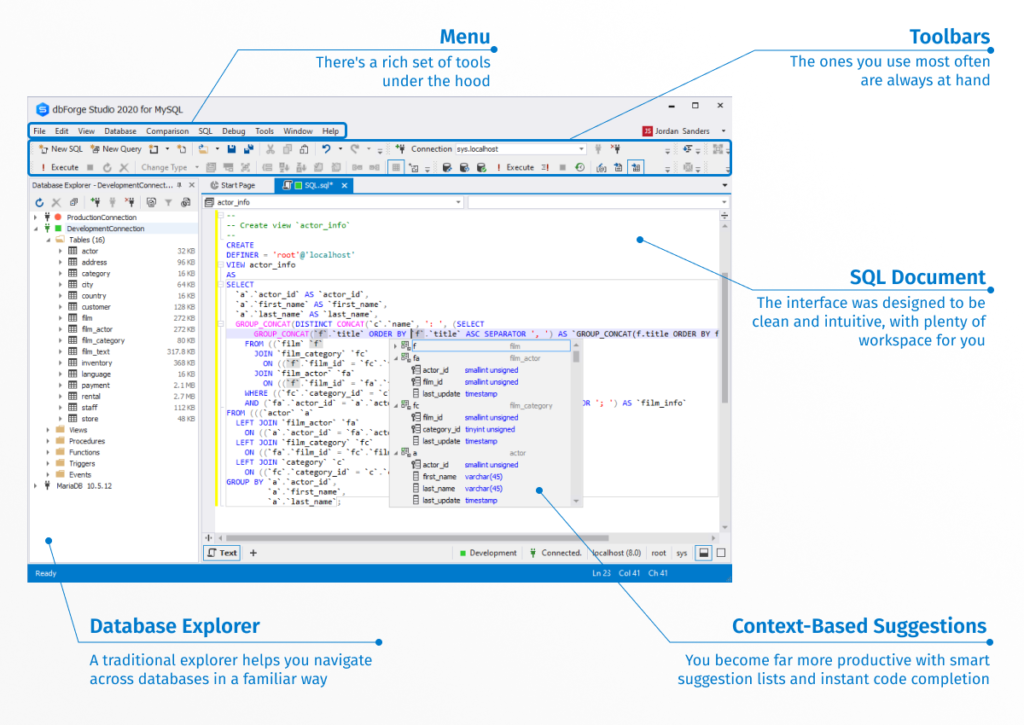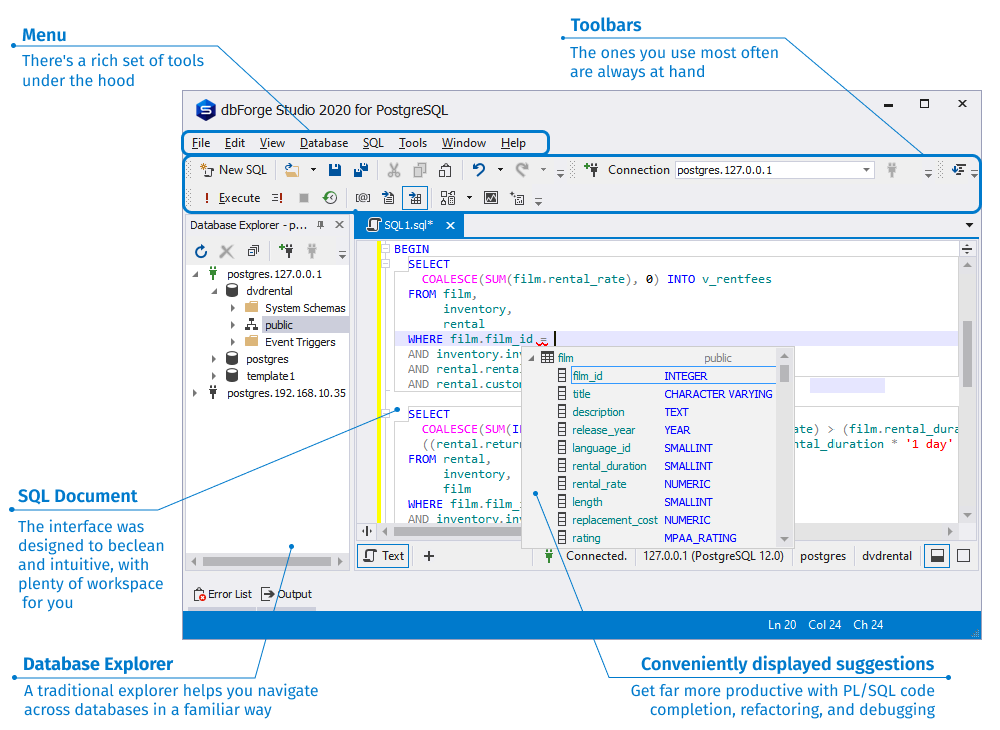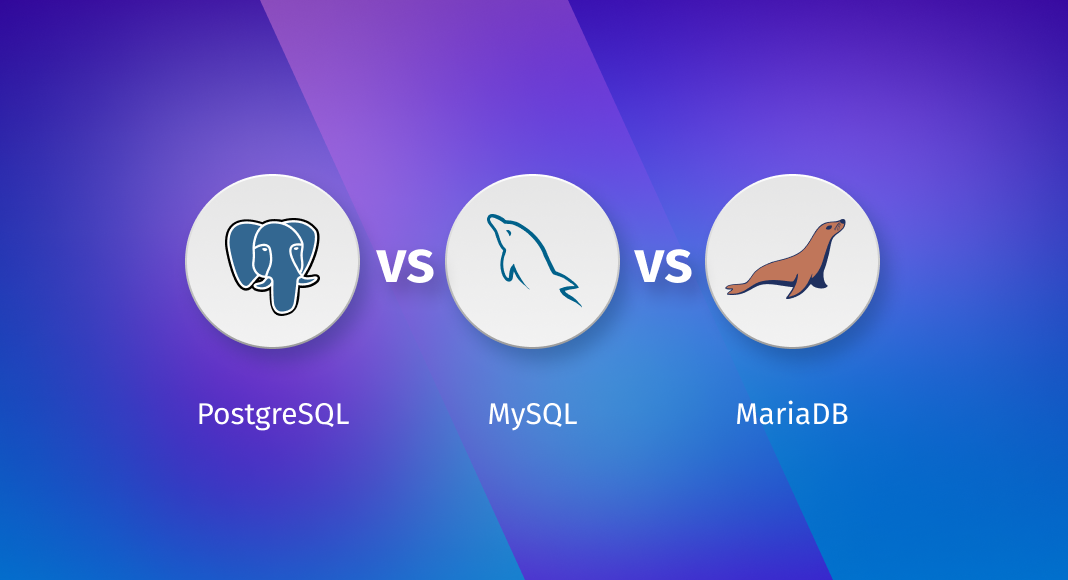When it comes to choosing the database management system (DBMS), questions arise. You need the one that will match your needs and deliver the highest effectiveness while solving the challenges you face. In this article, we are going to discuss the differences between PostgreSQL, MySQL, and MariaDB database management systems.
Contents
- PostgreSQL, MySQL, and MariaDB databases
- Key differences between MySQL, MariaDB, and PostgreSQL
- PostgreSQL vs MySQL/MariaDB detailed comparison
- Which database system is better: MariaDB, MySQL, or PostgreSQL?
- How to migrate MySQL to PostgreSQL
- How to convert Postgres database to MySQL
- Postgres, MySQL, MariaDB, and dbForge
- Conclusion: PostgreSQL vs MySQL vs MariaDB
PostgreSQL, MySQL, and MariaDB databases
First, let’s take a close look at Postgres and MySQL databases.
PostgreSQL (Postgres) is a free, open-source object-relational database management system with a rich feature set and robust customization capacities. Postgres is compliant with atomicity, consistency, isolation, and durability (ACID) properties. It is user-friendly and suitable for both professionals and beginners.
MySQL is an open-source relational database management system (RDBMS) that allows us to store and organize data in tables. The tables are related to each other and thereby they structure the data. For a deeper understanding of its core functionality and structure, see this detailed overview of what is MySQL database.
MariaDB is an open-source RDBMS that emerged as a fork of MySQL. Though it was nearly identical to MySQL in its early stages, MariaDB has since undergone significant evolution. It still maintains strong similarities with MySQL, however, over time, it has gained popularity as a distinct RDBMS provider.
Key differences between MySQL, MariaDB, and PostgreSQL
Now that we have a brief background on PostgreSQL, MySQL, and MariaDB, let’s discuss the key differences between these database management systems.
RDBMS vs ORDBMS
MySQL and MariaDB are relational database management systems (RDBMS) while PostgreSQL is an object-relational database management system (ORDBMS). In MySQL and MariaDB (and other RDBMSs) all tables are interrelated. PostgreSQL, in its turn, combines the characteristics of both RDBMS and object-oriented relational database management systems. It contains not only interrelated tables, but also supports objects, classes, and inheritance.
License
All three systems are open-source, but MySQL is maintained by the Oracle Corporation, while Postgres is maintained by volunteers, and the same goes for MariaDB.
Replication
Replication of data from a database on one machine to the database on another one ensures that all users have the same amount of information available. Replication is done on a regular basis. A distributed database allows for multiple users’ simultaneous work.
MySQL and MariaDB provide master-standby replication. PostgreSQL supports it too and also has improved WAL processing, thus allowing for near-real-time replication and standby capabilities with minimal downtime for standby servers.
Performance
MySQL and MariaDB are faster for read-heavy operations. It is the reason why these systems are chosen for OLAP/OLTP systems where quick reads are the primary point.
PostgreSQL excels when working with huge datasets and complicated queries. It is great for concurrent write operations, and it is a perfect choice for business intelligence and data science tasks.
Security
MySQL implements access control (ACL) security for any operations a user may attempt to perform. MariaDB checks permissions and authorizes access for accounts, rather than users. PostgreSQL has ROLES and legacy roles for setting and maintaining permissions. It also has native support for SSL connections and client/server message encryption and row-level security. PostgreSQL has the SE-PostgreSQL extension that provides additional access controls based on the SELinux security policy.
NoSQL support
Originally, MySQL didn’t provide any NoSQL support, but its 8.0 version introduced MySQL Cluster enabling users to apply the most essential features of both relational and NoSQL technologies. MariaDB supports plenty of commands that relate to NoSQL rather than to SQL. PostgreSQL offers NoSQL support too.
| MySQL | MariaDB | PostgreSQL |
| Open-source relational database system owned by Oracle | Open-source relational database system | Open-source object-relational database system |
| www.mysql.com | mariadb.org | www.postgresql.org |
| Released in 1995 | Released in 2009 | Released in 1989 |
| Current version: 8.0.33 | Current version: 11.0.2 | Current version: 15.3 |
Command-line application: mysql | Command-line application: mysql | Command-line application:psql |
| Official GUI tool: MySQL Workbench | Official GUI tool: MySQL Workbench | Official GUI tool: pgAdmin |
| Supports multi-source replication and source-replica replication | Supports multi-source replication and source-replica replication | Supports source-replica replication only |
| ACID-compliant | ACID-compliant | ACID-compliant |
| Supports Common Table Expressions, full-text search, JSON data type, UPSERT | Supports Common Table Expressions, full-text search, JSON data type, UPSERT | Supports Common Table Expressions, full-text search, JSON data type, UPSERT, materialized views, array data types, and partial indexes |
PostgreSQL vs MySQL/MariaDB detailed comparison
In this section, we are going to examine significant differences between PostgreSQL and MySQL/MariaDB. These databases share many features in general, but when it comes to practice, lots of essential factors arise and determine the usage of this or that DBMS. To help you make an informed decision, we offer below a comprehensive comparison of MySQL, MariaDB, and PostgreSQL.
Popularity
All these database management systems have active communities whose main goal is to ensure continuous evolution and improvement. MySQL and PostgreSQL are the default tools for building many applications, while MariaDB follows the leaders and is beginning to catch up.
In terms of MySQL vs PostgreSQL, the former possesses a bigger market share, but PostgreSQL is considered to be a more advanced system, therefore, ratings may change in the nearest future. MariaDB is close to entering the top 10 most popular RDBMSs in the world.
Syntax and queries
When it comes to syntax, there is almost no difference between PostgreSQL, MySQL, and MariaDB as they are based on the SQL standard. The example of the SELECT statement is as follows:
MySQL/MariaDB:
SELECT * FROM records;PostgreSQL:
SELECT * FROM records;Actually, the absence of PostgreSQL vs MySQL/MariaDB query differences even allows queries to be interchangeable in these DBMSs.
Indexes
PostgreSQL allows the creation of an expression index resulting from expression functions as opposed to column values. It’s also possible to create hash indexes and B-tree indexes as well as partial indexes that organize the data from a part of the table.
MySQL and MariaDB support indexes that are stored in B-Trees such as INDEX, FULLTEXT, PRIMARY KEY, and UNIQUE. It is also possible to create indexes stored in R-trees as well as Hash indexes and inverted lists when used together with the FULLTEXT index.
Data types in tables
Postgres supports a greater range of data formats and, therefore, it may be preferable if your application requires the unique data types supported by this RDBMS, as well as unstructured data in large tables. All DBMSs are fine if you only use basic character and numeric data types.
PostgreSQL supports the following data types: numeric, date/time, character, boolean, enumerated, geometric, network address, JSON, XML, HSTORE, arrays, ranges, and composite.
MySQL and MariaDB support data types: numeric, date/time, character, spatial, and JSON.
Performance and speed
Postgres performs faster by default because it supports concurrent writing operations without the need for read/write locks. It also implements transaction isolation and snapshots and is fully ACID compliant. MySQL/MariaDB, on the other hand, seeks to achieve concurrency by employing write locks. As a result, the number of concurrent activities per process is reduced. You’ll need to add a lot of resources to MySQL to scale in production environments. MariaDB is faster than MySQL but still inferior to PostgreSQL in performance and speed.
However, one area where MySQL shows better results is in read-intensive processes. Because most applications just read and display data from a database, a basic MySQL implementation outperforms a PostgreSQL one. This is due to the fact that when Postgres forks a new process for each connection, it allocates a substantial amount of memory (about 10MB). This results in ballooning memory use, which essentially eats away at the system’s resources. As a result, speed is sacrificed in favor of data integrity and standard compliance.
ACID compliance
Even when several modifications are made within a single transaction, ACID (Atomicity, Consistency, Isolation, Durability) compliance assures that no data is lost or miscommunicated across the system in the event of failure. All systems are ACID-compliant.
Replication clustering and scalability
MySQL, MariaDB, and PostgreSQL all offer replication. Replication in MySQL and MariaDB is one-way asynchronous. PostgreSQL, on the other hand, supports synchronous replication, as well as cascade and synchronous replication.
MySQL offers MySQL Cluster, a multi-master database that prioritizes linear scaling. It uses synchronous replication internally, despite having one-way asynchronous replication. MySQL avoids any negative impact and transaction failures by removing single points of failure from the system and ensuring that data is written to diverse nodes.
In terms of clustering, PostgreSQL allows for streaming or synchronous replications, as well as Postgres-XL, a database clustering environment.
JSON support
MySQL supports JSON but not doesn’t support indexing for JSON. In its turn, PostgreSQL supports both JSON features and indexing JSON data for faster access.
Support for programming languages
MySQL and MariaDB provide support for Delphi, Erlang, Go, Java, Lisp, Perl, PHP, R.
PostgreSQL supports a somewhat higher number of languages, including Java, JavaScript, Python, R, Tcl, Lisp, Erlang, and others.
Ease of use for beginners
When it comes to the question of MySQL vs PostgreSQL ease of use for beginners, MySQL is more user-friendly, and it takes less time to build a project from scratch. Newbies, on the other hand, may find the learning curve in PostgreSQL excessively harsh. MariaDB, due to its close relation to MySQL, is also significantly easier to master for beginners. Besides, PostgreSQL support may be less substantial and active.
Which database system is better: MariaDB, MySQL, or PostgreSQL?
MySQL is simple to set up as a stand-alone product or as part of a stack, such as the LAMP stack. Most web hosting packages contain MySQL databases. You may access it via database management software like phpMyAdmin.
With PostgreSQL, it’s more likely that you’ll need to set up a development computer or run a virtual server and install PostgreSQL yourself.
In terms of accessibility for novice developers and analysts, MySQL has the upper hand. As for MariaDB, knowledge of MySQL provides you with a pretty good background for mastering it quickly.
That isn’t to argue that PostgreSQL isn’t the best option for a specific application, particularly the resource-intensive one that could benefit from improved security and load balancing. However, since MySQL is more widely used, it is more accessible.
In addition to the platform itself, you’ll also need to think about what third-party applications and integrations you’ll require for your infrastructure.
Why use MySQL?
Here are a few compelling reasons to use MySQL:
- Support for master-slave replication and Scale-Out
- Offload Reporting and Geographic Data Distribution
- Low overhead of the MyISAM storage engine when utilized for read-only applications
- Memory storage engine support for frequently used tables
- Query Cache for frequently used statements
- Lots of resources to learn and troubleshoot MySQL
Why use MariaDB?
MariaDB can be a perfect replacement for MySQL as it includes all the functionality available in MySQL and offers more features.
Here are the reasons why using MariaDB is worth considering:
- Full access to all features immediately after installation
- Complete backward compatibility
- Availability of all features found in the latest MySQL version
- 100% compatibility with MySQL in terms of client protocols, APIs, structures, etc.
- A broader range of security features compared to MySQL
- More storage engines and a larger connection pool than in MySQL
- Improved performance compared to MySQL
- Support for data masking and dynamic columns
Why use PostgreSQL?
Developers might choose PostgreSQL over MySQL because it is considered to be better, faster, and much more functional.
The following are the main reasons to choose PostgreSQL:
- Table partitioning, Point-in-Time Recovery, and Transactional DDL features
- Ability to utilize 3rd party key stores with full PKI infrastructure
- Since PostgreSQL open-source code is distributed under the BSD license, developers can modify it without having to contribute back enhancements
- Object-level privileges can be provided to users and roles
- Support for AES, 3DES, and other data encryption techniques
- Spatial indexing features
How to migrate MySQL to PostgreSQL
Is it possible to move MySQL databases to PostgreSQL? It can be easily done with a helpful IDE that is specifically designed to save time and energy for users. Data migration between these two DBMSs can be supported by an ODBC driver to ensure flawless processes. A detailed tutorial on how to migrate MySQL to PostgreSQL is available online, just follow this link.
How to convert Postgres database to MySQL
Database migration from PostgreSQL to MySQL can be quite a challenging and time-consuming task. However, professional tools make it much simpler. One such tool is a powerful converter available in dbForge Studio for PostgreSQL and based on the ODBC driver.
Postgres, MySQL, and dbForge
dbForge product line offers tools for database development, management, and administration for all major DBMSs: SQL, MySQL/MariaDB, PostgreSQL, and Oracle. In particular, users highly value dbForge Studios — all-in-one IDEs that allow covering all work tasks with one powerful software solution.
dbForge Studio for MySQL and MariaDB
dbForge Studio for MySQL delivers everything you might need to build and manage databases, simplify the workflow, ensure high performance, and reduce costs, all within a neat and user-friendly interface. As a powerful MariaDB client GUI, the Studio provides full compatibility with MariaDB, enabling users to perform all database-related tasks just as they would for MySQL.
Over the years, this IDE proved invaluable to both MySQL and MariaDB database developers, data analysts, DBAs, and data scientists.
Top reasons to choose dbForge Studio for MySQL
- Advanced code completion and syntax check
- Comparison and synchronization of database schemas and table data
- Visualization of queries on diagram without coding
- Export and import of MySQL and MariaDB databases
- Backup and recovery
- Database projects and version control integration


dbForge Studio for PostgreSQL
dbForge Studio for PostgreSQL offers robust database development and administration capabilities embracing the essential tools in one universal solution that is designed to accelerate your productivity and deliver more value to your customers.
Top reasons to choose dbForge Studio for PostgreSQL
- IntelliSense-like SQL code completion and formatting
- Query optimization
- Export and import of PostgreSQL databases
- Generation of data reports
- Data aggregation in pivot tables


dbForge Edge
dbForge Edge is the newest product introduced by Devart, the most robust and comprehensive software solution available — the multidatabase IDE that covers all tasks on all major database management systems: SQL Server, MySQL/MariaDB, Oracle, and PostgreSQL.
Edge comprises the functionality of all Studios. It is the most convenient option if you deal with various RDBMSs in your work.
Conclusion: PostgreSQL vs MySQL vs MariaDB
All the database management systems described and examined in this article are great choices for database experts, though, of course, they all have some distinctive features making each system more or less suitable for any particular scenario.
In brief, PostgreSQL beats MySQL in complex queries, while MySQL crushes Postgres (when using InnoDB) in simple queries. Besides, MySQL and MariaDB are more user-friendly. It is also easier to find devs and DBAs for MySQL/MariaDB as compared to PostgreSQL. But Postgres is still better for analytics tasks.
In any case, if your work duties suggest dealing with these systems, you can streamline your work routines with Devart dbForge products. It could be a dedicated Studio for MySQL/MariaDB or PostgreSQL (or both), or dbForge Edge that allows you to cover all these DBMSs at once (and be ready to catch new tasks related to SQL Server and Oracle). A fully-functional free trial is available for each IDE for 30 days, so you can test and evaluate the functionality and performance in your workflow at full capacity.

